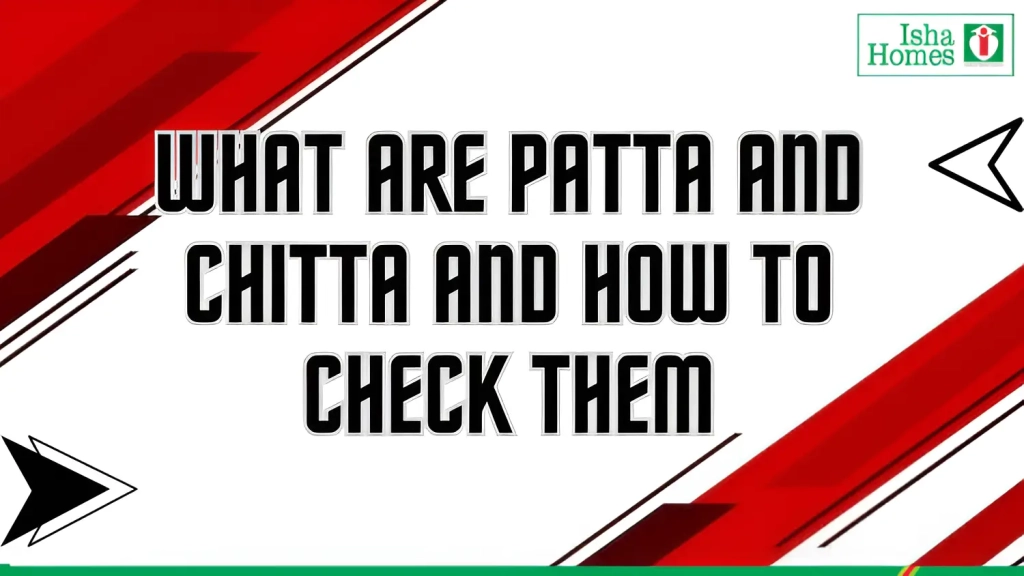We might have heard the terms Patta and Chitta while discussing real estate and properties. Did you know what patta and chitta are? Patta and Chitta are crucial documents in establishing and safeguarding home ownership in Tamil Nadu.
Did you know that over 90% of land documents in Tamil Nade have been digitalized as of a report from 2022? Land documentation has been made easy and transparent with digitalization.
Proper documentation is essential for a property. Patta and Chitta serve as the backbone of the property and safeguard the property in case disputes arise. The article aims to share the significance of Patta and Chitta and the different ways to check them.
Understanding Patta and Chitta
In Tamil Nadu, Patta is a legal document issued by the government stating the ownership of a property owned by an individual or an entity. It is one of the crucial documents in possession of a property.
The concept of Patta traces its roots to the ancient periods when lands were documented using traditional methods. Over the years it has evolved to be the formalized document established by the government to the individuals that state their ownership of the land.
Patta provides a sense of security since it is a government-issued document that shows ownership. The document is crucial while selling, renting, or leasing the property. Financial institutions require patta for sanctioning loans. The patta should be updated regularly to prevent property disputes.
A patta contains the following information:
- Owner’s name: This section contains the name of the land owner who has the right to the land
- Survey numbers and subdivision details: This section has the land’s location details, specifically the administrative division. It also includes details of the survey numbers and subdivision numbers. Those unique codes are used to identify the specific piece of land
- Location of the property: The exact location of the land (district, taluk) has to be specified in the document
- Size of the land and classification: The document should specify the category of the land (Wetland (Nanjai nilam)/ dry land (punjai nilam)) to calculate which crops are suitable for the land whether paddy and rice or crops that require less water
- Revenue payment details: This section furnishes revenue details of the land such as outstanding payments and land taxes paid.
In short, a patta is a legal document that acts as a Record of Rights (ROR).
Chitta
Before 2015, Chitta existed as a separate document having the land revenue extract. In other words, it contained the information derived from the Village Administrative Officer (VAO)
Just like patta, chitta serves the same purpose. It contains the ownership details of the proposed piece of land and the classification of the land, whether it is a wetland or a dry land. These details help government officials understand land usage, the primary source for land surveys, land revenue assessment, land development planning, and solving land disputes.
What is the Difference Between Patta and Chitta?
However, Patta and Chitta are more or less the same, but there are some subtle differences. Here are some differences between patta and chitta:
- In terms of purpose, Patta serves as a legal document provided by the government that establishes homeownership of the proposed land. Chitta on the other hand furnishes details regarding the land, such as the survey number, area measurement, location of the land, and type of land. In short, Chitta is a comprehensive document that contains all the necessary information related to the land
- In terms of the information contained, Patta contains details such as survey number, details of the property, and location. Whereas, Chitta has details such as survey number, location, classification of the land (residential or agricultural), and also encumbrances of the land and liabilities of the land
- Talking of legal status, Patta is a significant document that provides landownership and acts as the most important document while buying, selling, or leasing a particular piece of land. On the other hand, Chitta acts as a supporting document that possesses all the information related to the property. Moreover, it has a track of ownership of the proposed land.
The Merger
It was only after 2015 that the government merged both Patta and Chitta and started information contained in both documents in one. The reason for the merger is that both documents provide more or less the same information. To eliminate the redundancy, the government took such a measure.
The merged document was named Patta Chitta (read together). This consolidated document contains all the necessary details to make the transactions transparent and avoid disputes.
How to Check Patta and Chitta?
Moving further, let us see how to check Patta and Chitta. There are two ways to check Patta and Chitta, they are as follows:
Offline Method
The first way to check Patta and Chitta is the traditional way where you have to do and approach the concerned officials in person and make a request. Here’s the step-by-step guide to traditionally checking your Patta and Chitta:
- Approach your Taluk Office or the Village Administrative Officer (VAO): Approach your Taluk office and make a request to the officials, they will guide you through the process since they handle land-related matters. Alternatively, you can approach your Village Administrative Officer (VAO). The VAO maintains land records and they will help you with your Patta Chitta extract
- Requesting the document: The next step is to make a formal request. Which usually means filling out a form or giving a letter requesting the patta chitta extract. The letter must clearly state the purpose of the request
- Provide necessary documents: Before approaching the Taluk office or the Village Administrative Officer, take your government-issued document (Aadhar card), and your land details such as the village name and survey number which will make it easy for the officials to find the extract
- Processing fee: After making the request check whether you have to pay any processing fee along with the submission of the request letter
- Receive your Patta Chitta: Upon submitting the request letter, you will be asked to wait till the government officials process your application and run a search. The processing time differs from place to place. You will be intimated when the process is completed and you will be provided with your Patta Chitta extract with which you can claim ownership of your land.
It is advised to keep the photocopies of the original documents, your government-issued document, and the processing fee ready to speed up the process. It is better to verify the turnaround time for receiving the Patta Chitta extract to avoid confusion and be informed that the processing time differs from place to place according to their workload.
Online method
Going all the way to the Taluk office or approaching the Village Administrative Officer and waiting till the processing is done can be exhausting. At times, it may take weeks up to months for you to get your Patta Chitta extract from the office due to various reasons.
Considering the issue, the government of Tamil Nadu has come up with an easy remedy where you can get a copy of your Patta Chitta by yourself in the comfort of your home. The process is cost and time-effective. Here’s a step-by-step guide to get your Patta Chitta copy online:
- The government of Tamil Nadu has come up with an easy way to get a copy of your Patta Chitta online. They have uploaded all the Patta Chitta documents across Tamil Nadu on the internet so that people can access them with ease.
- Access the e-service portal. On the homepage, navigate to the option to view the Patta/Chitta (Rural/Natham) option (Check the image below)
- You will be directed to the new page where you can fill in all the required details
- Type the name of your district where the proposed land is in the District section, you can also use the drop-down option and choose your district
- Then type your Taluk, upon selecting your district you can use the drop-down option to choose your Taluk, browse the village section, and choose your village
- You can see the ‘View Patta Chitta using’ option where you can choose between the Patta number and Survey number, you can choose the one that is suitable for you
- Moving on, choose the Land type whether your land falls under the category ‘Rural’ or ‘Natham’
- Type the Patta/Survey number in the respective section and type the captcha given carefully
- Re-check whether all the details given are correct and click on ‘Submit’
- Upon submission, you will be redirected to a page where you can download a copy of your Patta Chitta in your desired format
- It is advised to download the copy for future reference.
Additional considerations
- Significantly, update your Patta and Chitta since they provide ownership of the proposed land. Transactions like buying, selling, and leasing the land will be impossible without Patta and Chitta
- Banks consider Patta Chitta as the most important document to sanction loans. Furthermore, the document will come in handy in case of property disputes.
Let’s do a recap
Patta Chitta is the most important document since it provides landownership. It can be checked by following two methods–online and offline. In the case of the online method, you can log on to the government e-service website, fill in the required details, and get a copy of your Patta Chitta. Whereas, you have to approach your Taluk office or the Village Administrative Officer and request your Patta Chitta. However, it may take some time. The turnaround time differs from place to place according to the workload.
Want to buy your dream house?
Consider, Isha Homes, we are the best builder in Tamil Nadu. We have helped more than 3500 families with their dream houses. Our commitment to customer satisfaction and customer-centered approach is the reason for our success. Our extensive portfolio showcases various completed projects and testimonials from our customers. We have a wide array of affordable apartments, villas, and plots.
Take a look at our ongoing projects and decide it yourself.
Doubts? Give us a call. Our expert team will take you from there.


